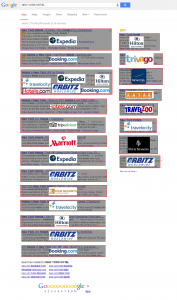How CVBs and Hotel Lodging Associations can Win Over Local Hoteliers and Win Back Google Rankings Over OTAs

So where are the CVBs (convention and visitors bureaus) and lodging / hospitality associations in all of this? Right now, it seems like they are just letting the OTAs do their own thing rather than effectively capitalize on any share of local booking traffic revenue and official destination information. Here’s an example that could be coming to a major market near you. If you Google search ‘New York Hotel’, here’s what comes up: an OTA-dominated representation of the local New York travel market.
Remember, the Achilles heel of an (OTA) is similar to any multi-national company—they can do search marketing great at a national level, but once you break down into local marketing segments, they start to lose relevance. This is really where the CVBs and local hotel / lodging associations can have a superior advantage and opportunity while greatly benefiting local hoteliers.
I’ve outlined five steps for these tourism-related entities to seize their local territory, better inform and market their members online and create a reduced commission structure for the hotel while adding a continuous stream of income (commission and ad sales) to the lead organization, be it a CVB or lodging / hospitality association. here are the five steps for CVBs and hotel lodging associations to win over local hoteliers and win back Google rankings over OTAs
Step 1- Education
CVBs and lodging associations can educate their members on how to improve their websites, perform basic Google optimization and protect against predatory OTA practices. Members can partner with a local Google Partner digital marketing company, have a sharp employee tackle the initiative or hire an optimization expert.
Here are the Top 10 items that should be reviewed with the local hotels in order to empower and protect them, as well as enhance their revenue:
- Google Local Listings (soon to be Places)
- Google Plus Page – both Author and Publisher
- Google Hotel Carousel
- Google AdWords
- Facebook Profile
- Yelp Profile
- Foursquare Profile
- Twitter Profile
- Hotel Schema MarkUp
Step 2 – Unite
The fundamentals of an association like a CVB or hospitality association boil down to members joining resources together to work for the common good, achieving more by working together rather than alone. With a fearless, active leader directing members and resources as needed, you’ve got a recipe for great success.
Here’s where there is great opportunity for change as the eerie, fear-induced silence in the market from hotels and CVBs toward OTAs is allowing the OTAs to gain even more control (and revenue share) in various tourist markets. CVBs and local hotel / lodging groups could build a robust reservation system for their local territory that follows the successful OTA model that shows who is booking now, lends a sense of urgency and provides ratings / reviews. In addition, the site could provide official visitor information and offer a competitive advantage for relevant, local information. Who better to cover your market—local bloggers, local photographers and local event producers or some guy with Booking.com sitting in his cubicle on another continent several time zones away?
Once the reservation system is built, I would run AdWords just on the specific area, essentially creating an OTA for your own local territory. It’s critical that each hotel has a separate AdWord campaign that takes visitors to a specific hotel landing page. It’s also critical to have non-branded hotel campaigns focusing on types of travelers and geographical areas that take them to specific pages for booking based by theme. In other words, if you are running a romantic getaway campaign, clicks should go to a romantic hotels landing page and not a generic hotels page. These simple tips really help with conversion.
So how do you finance such a thing? The initial reservation system build-out could be amortized over a certain period for the CVBs or local hotel / lodging association. Revenues would come from commission-paying hotels for reservations booked on the site in addition to potential ad and partnership revenue.
Step 3 – Remarketing and Email Campaign
Google Remarketing is a great way to get inexpensive reservations to the new local reservation system. It reaches people who have previously visited the website as they visit other sites on the Google Display Network or search on Google. Using remarketing, the reservation system can tailor customer messages based on which sections of the reservation system they visited. Remarketing is not limited to just the Google Display Network—AdRoll remarkets to Facebook and other social media sites.
After a period of time this new reservation system will generate many email addresses which need to be segmented into different groups—maybe by price or hotel type or originating market—as you build the database of frequent travelers. Equally important are reviews! Guests should be emailed after their stay with a brief survey as well as an ask to rate or review the hotel on the reservation system or one of the hotel’s social media profiles.
Step 4 – Amass Data
Armed with information, CVBs, lodging associations and the local hotelier can begin to make some headway in their struggle with the OTAs. Travelers will leave behind a trail of information that’s important to gather and analyze such as the following: How was the reservation made? Was a mobile or tablet device used? What was the average length of stay? Where does the visitor get their reviews from? Who do they trust? Why did they choose one hotel against another? How often do they travel? Are they using your location as a stopover? If so, are there any cross-partner opportunities with other locations? The list is endless, but the need is the same—know your guest before the OTA figures it out and takes the reservation.
Step 5 – Shift Your Mindset
Although social media is still relevant and important, posting as many sunsets and sunrises as you can in one month is not going to work. Running the same ad campaigns, commercials, creative and PR stunts won’t continue to work either. The world has become digital, and it’s not going to change so that means you need to!
To understand the mindset of a major market CVB, I called Stacie Faulds, creative director of the Greater Fort Lauderdale Convention & Visitors Bureau. I’m obviously a pro-digital marketer and see great value in building a budget that would include about 50% of a marketing budget allotted to digital media. In the case of Greater Fort Lauderdale, that split is about 15% digital right now according to Faulds.
When I spoke with her about the OTA domination, she countered that there really isn’t any dominant force online for visitor booking (my facts and figures show differently), noting that Millennials, Generation X and Boomers are using different online sources for their travel planning, many of them still using travel agents and tour operators to book travel. She said that OTAs were one of many ways to book travel to the destination and that sales were showing a strong uptick. Visitors can also book directly on Facebook now at www.Facebook.com/visitlauderdale and on airline websites, individual hotel websites and the CVB official tourism site Sunny.org (which could evolve into the model I am describing).
In terms of arming their hoteliers with information to help them succeed in marketing, Faulds said that they give these tips:
- Showcase your hotel pictorially. Photos and videos have become a top resource point before a decision is made. Photo showing authentic experiences have more credibility.
- Go mobile. More people are looking and booking from their mobile device. Enhance your mobile site and make booking a breeze.
- Participate in Greater Fort Lauderdale CVB promotions, like Summer 2-for-1 Savings, Vacation Like a VIP, Cruise and Play, Spa Chic, Dine Out Lauderdale and year-round LauderDeals.
So while some value is being given to the local hoteliers in Fort Lauderdale, I feel much more could be done to put more money in their pockets and into the local economy. The CVB’s budget and strategy reflect their continued belief in traditional offline relationships, advertising campaigns, public relations events and heavy investment in social media. All of these are fine strategies, but to really compete in today’s OTA-saturated environment and put heads in beds in your local market, you need a strong digital strategy to retain local control (and revenue) for both your organization and your individual hoteliers.
This blog was featured in tnooz.com – http://www.tnooz.com/article/hotel-marketing-tips-destination-marketing/
Travel Tech Strategies is a forward-thinking market leader providing the travel industry with in-depth Big Data analysis

